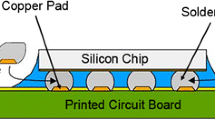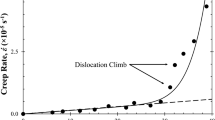Abstract
This paper describes the creep behavior of three tin-rich solders that have become candidates for use in lead-free solder joints: Sn-3.5Ag, Sn-3Ag-0.5Cu, and Sn-0.7Cu. The three solders show the same general behavior when tested in thin joints between copper and Ni/Au metallized pads at temperatures between 60‡C and 130°C. Their steady-state creep rates are separated into two regimes with different stress exponents. The low-stress exponents range from ∼3–6, while the high-stress exponents are anomalously high (7–12). Strikingly, the high-stress exponent has a strong temperature dependence near room temperature, increasing significantly as the temperature drops from 95°C to 60°C. The anomalous creep behavior of the solders appears to be due to the dominant tin constituent. Research on creep in bulk samples of pure tin suggests that the anomalous temperature dependence of the stress exponent may show a change in the dominant mechanism of creep. Whatever its source, it has the consequence that conventional constitutive relations for steady-state creep must be used with caution in treating tin-rich solder joints, and qualification tests that are intended to verify performance should be carefully designed.
Similar content being viewed by others
References
J.W. Morris, Jr. and H.L. Reynolds,Design and Reliability of Solders and Solder Interconnections, ed. R.K. Mahidhara et al. (Warrendale, PA: TMS, 1997), p. 49.
M.C. Shine and L.R. Fox,Low Cycle Fatigue, ASTM STP 942, ed. H.D. Solomon et al. (Philadelphia, PA: 1988), p. 588.
K. Suganuma,MRS Bulletin, 26 (2001), p. 880.
J.E. Bird, A.K. Mukherjee, and J.E. Dorn,Quantitative Relation Between Properties and Microstructure, ed. D.G. Brandon and A. Rosen (Jerusalem, Israel: Israel University Press, 1969), p. 255.
Z. Guo, Y-H Pao, and H. Conrad,J. Electron. Packag., 117 (1995), p. 101.
J.E. Breen and J. Weertman,Trans. AIME, 203 (1955), p. 1230.
S.H. Suh, J.B. Cohen, and J. Weertman,Metall. Trans. A, 14A (1983), p. 117.
J.P. Poirier,Acta Metall., 26 (1978), p. 629.
R.E. Frenkel, O.D. Sherby, and J.E. Dorn,Acta Metall., 3 (1955), p. 470.
F.A. Mohamed, K.L. Murty, and J.W. Morris, Jr.,Metall. Trans., 4 (1973), p. 935.
P. Adeva et al.,Mater. Sci. Eng. A, A194 (1995), p. 17.
M.D. Mathew et al.,Creep Behaviors of Advanced Materials for the 21st Century, ed. R.S. Mishra, A.K. Mukherjee, and K.L. Murty (Warrendale, PA: TMS, 1999), p. 51.
L. Rotherham, A.D.N. Smith, and G.B. Greenough,J. Inst. Met., 79 (1951), p. 439.
R. J. McCabe and M. Fine,JOM, 52 (6) (2000), p. 33.
J.D. Meakin and E. Klokholm,Trans. Met. Soc. AIME, 218 (1960), p. 463.
C. Coston and N.H. Nachtrieb,J. Phys. Chem., 68 (1964), p. 2219.
V.I. Igoshev and J.I. Kleiman,J. Electron. Mater., 29 (2000), p. 244.
T. Reinikainen and J. Kivilahti,Metall. Mater. Trans. A, 30A (1999), p. 123.
R. Darveaux and K. Banerji,IEEE Trans. Comp. Hybrids, Manuf. Technol., 15 (1993), p. 1013.
H. Yang et al.,Proc. 46th Electron. Comp. Technol. Conf. (New York: IEEE, 1996), p. 1136.
H. Mavoori et al.,J. Electron. Mater., 26 (1997), p. 783.
Author information
Authors and Affiliations
Corresponding author
Rights and permissions
About this article
Cite this article
Song, H.G., Morris, J.W. & Hua, F. The creep properties of lead-free solder joints. JOM 54, 30–32 (2002). https://doi.org/10.1007/BF02701846
Issue Date:
DOI: https://doi.org/10.1007/BF02701846




